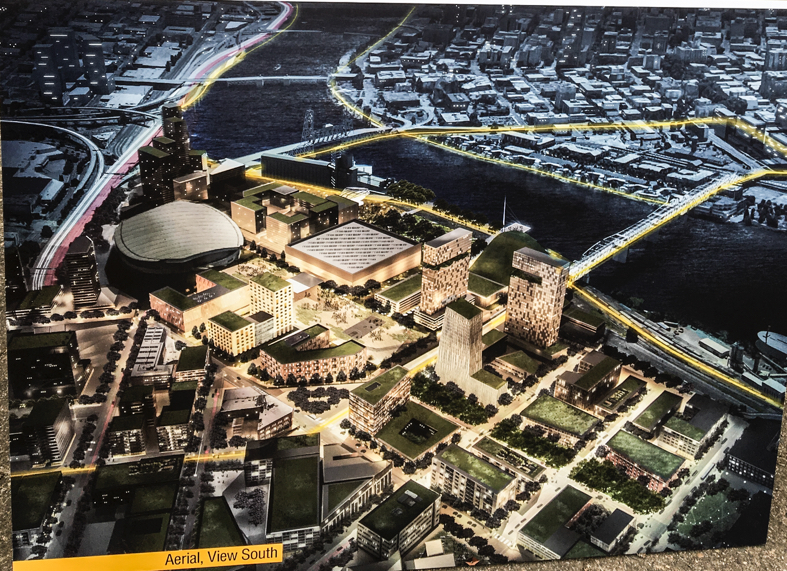
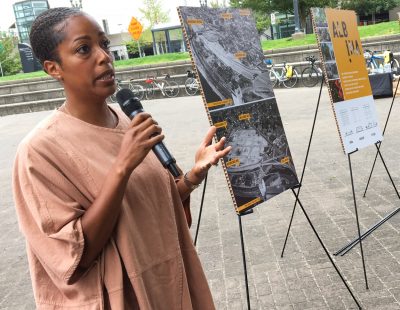
(Photo: J. Maus/BikePortland)
In the early 1950s, the Rose Quarter was a neighborhood of homes, churches and stores. It was a thriving part of our city where many people lived and worked. But by 1958 all the houses were razed to make way for the Memorial Coliseum and eventually the Moda Center. Within the same decade hundreds more homes would see the same fate as city planners gave Legacy Emanuel Hospital and Interstate 5 priority over housing and businesses. These “urban renewal” projects in the Albina corridor had a devastating impact to the community and many of the scars — on human lives and infrastructure — remain unhealed.
A bold new plan unveiled for the first time on Friday seeks to restore that neighborhood — and ideally, the community that went along with it. The “Albina Vision” would develop the 30-acre Rose Quarter with housing and businesses that respects history and embraces the future.
On Friday two of the project’s main backers — Rukaiyah Adams, chief investment officer with the Meyer Memorial Trust and Zari Santner, a former Portland Parks Bureau director — laid out their vision to a crowd of about 70 electeds, planners, advocates and government staffers during a stop on the annual Policymakers Ride.
“What we envision is… putting bikes and walkers first and not just having them be unsafe crossing giant highways and streets.”
— Rukaiyah Adams
Adams shared that her great-grandmother moved to the Rose Quarter after fleeing the violence of the Jim Crow south. “It was a lot like Ladds [neighborhood] today,” she said. “Imagine bulldozing Ladds Addition to build a soccer stadium.”
Standing in front of poster boards, Adams (a powerful and respected civic leader who also chairs the Oregon Investment Council) said the current Rose Quarter is an example of the “primacy of the car” and that she wants to, “rebuild a community, not just the physical spaces” of a neighbohood that she refers to as “ground zero for the discussion about equity and history in Portland.”
Adams said the group behind the vision (which according to the Willamette Week also includes Moda Health Executive Vice President Steve Wynne) has been meeting for a year. Their vision is to keep the Memorial Coliseum and Moda Center and build new buildings and streets around them. The Coliseum — and redevelopment of the Rose Quarter — has been the subject of intense debate and controversy over the years. The “Albina Vision” wouldn’t seek to demolish the Coliseum. Rather, Adams says, Portland must, “Be honest about the destruction of this neighborhood, not back away from that history.”
“The way we see it,” she continued, “the homes of black veterans were bulldozed to builld a monument mostly to white veterans — so this is our Robert E. Lee monument. We look at it and can appreciate the beauty and wanting to protect the architecture; but also feel like there’s a story about what we’re monumenting here that has to be told if it will be preserved.”
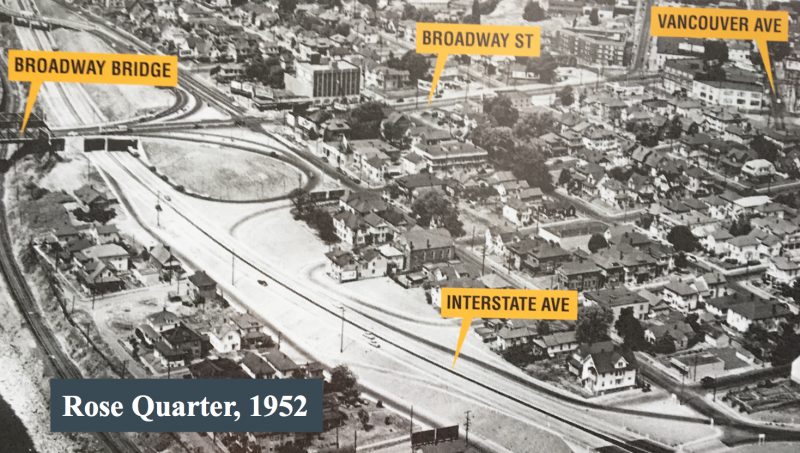
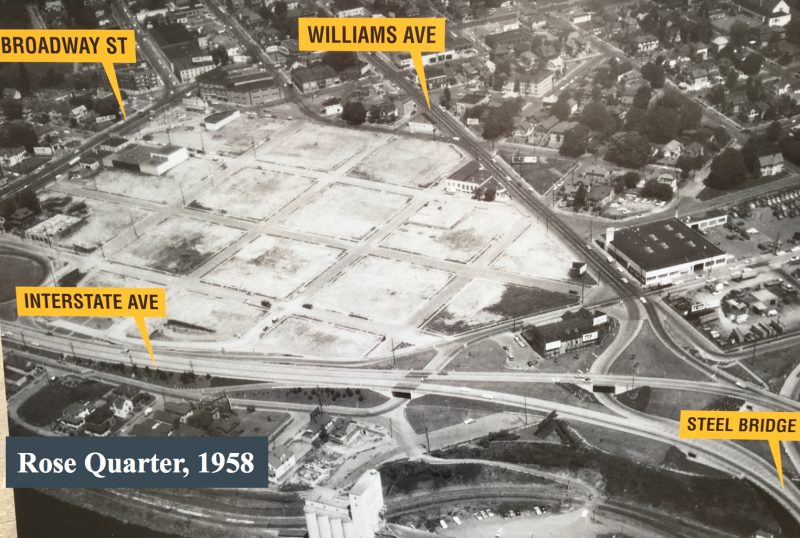


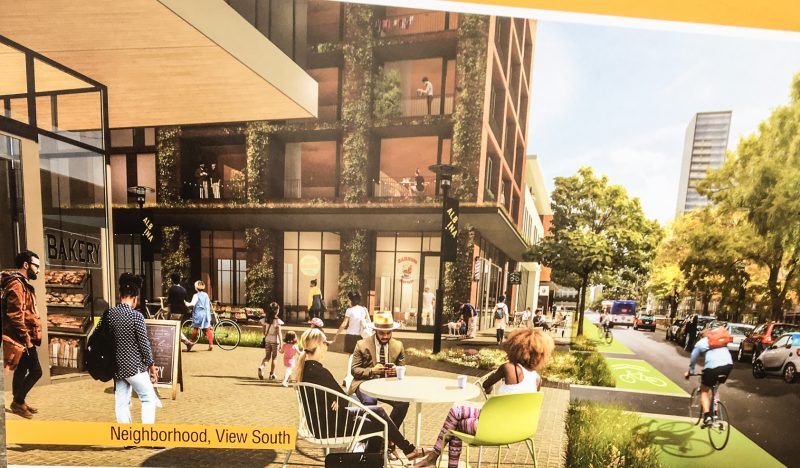
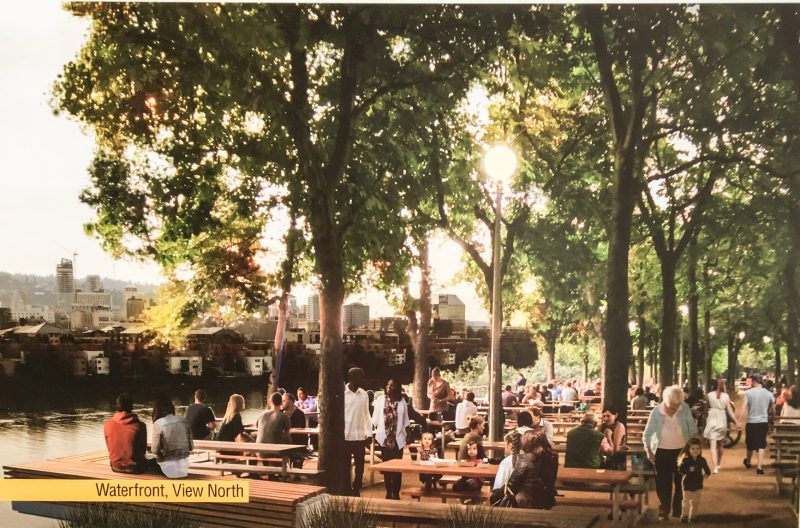
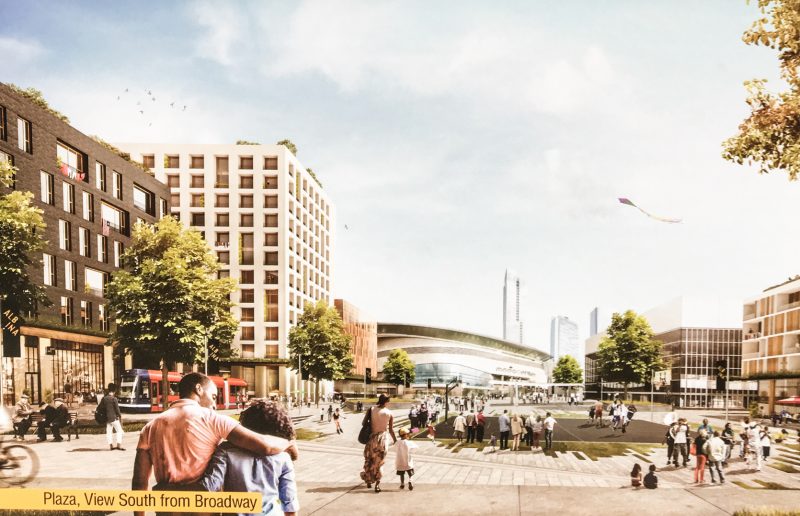

Advertisement
Beyond simply a development project with buildings and plazas, Adams and Santner understand the key mobility issues in the Rose Quarter. Adams spoke of restoring the street grid that used to exist in the 1950s. She then referred to the current conditions as a “system of giant buildings not accessible at the pedestrian level.” “What we envision,” she continued. “Is some combination of both and putting bikes and walkers first and not just having them be unsafe crossing giant highways and streets.”
Santner explained that the most important element of their plan is to bury the existing auto parking along Broadway. “Broadway was historically the central spine of this area and by constructing these parking garagaes, this area was totally severed visually and physically from Broadway,” she said. “The idea is to remove these parking garages and allow parking underneath these plazas so the Moda Center and Coliseum are connected to Broadway and to the neighborhood that would be built beyond it.”


Santner also addressed the “controversial” ODOT/PBOT project to widen I-5. “We don’t really care whether the freeway is going to expand or not. That’s not the issue,” she said. “What we care about is, if the freeway is there and it’s not removed, it needs to have a lid.”
Their plans call for a lid over the freeway from Clackamas Street (two blocks north of Multnomah) to beyond Broadway. And instead of just parks and trees like ODOT is proposing for the much smaller lids in the I-5 Rose Quarter project, Santner said they want to put buildings and streets above the freeway.
Another feature of the plan is a lid that would extend from the Memorial Coliseum over Interstate Avenue and the railroad tracks along the Willametter River (see images) in order to provide public river access to an area that is now industrial and inaccessible between the Steel and Broadway bridges. The project would, in Adams’ words, “Allow the connection to the river to be healed,” and “Give the river back to the people.”
“Our intent is to stitch back this area to the area to the east, Lloyd Center, and the north,” Santner said.
Right now the group behind Albina Vision sees themselves simply as curators and stewards. They say they want more partners and are in the process of forming a nonprofit. Asked if there was a group or project they modeled themselves after, Santner said I should compare them to Friends of the High Line in New York City. “They were just a friends group too at first,”she said. “But because the vision was so great and because it was embraced by the city, money rolled in and that’s what we want to do.”
Reminder: Tomorrow night (Tuesday, 9/12) is the first open house for the I-5 Rose Quarter project. Check the project website and plan to stop in Dishman Community Center between 5:00 and 7:00 if you can.
— Jonathan Maus: (503) 706-8804, @jonathan_maus on Twitter and jonathan@bikeportland.org
Never miss a story. Sign-up for the daily BP Headlines email.
BikePortland needs your support.



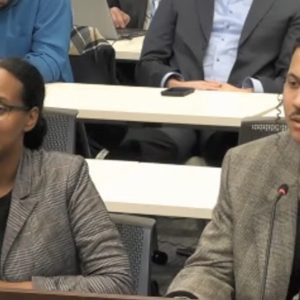
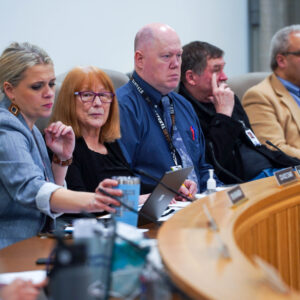
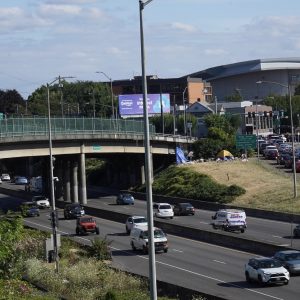
Thanks for reading.
BikePortland has served this community with independent community journalism since 2005. We rely on subscriptions from readers like you to survive. Your financial support is vital in keeping this valuable resource alive and well.
Please subscribe today to strengthen and expand our work.
Beautiful!
Glad you approve Betsy! (for the unitiated, Betsy has been a stalwart advocate for improvements in/around the Rose Quarter as she’s the former owner of a apartment bldg and still owner of a parking lot in the area).
It will be really interesting to see how/if this impacts the planning and process for the I-5 Rose Quarter project.
Wow.
Wow..this came out of left field! Looks pretty amazing to me!
Nice images. Wouldn’t it be stronger if this project was tied/linked/unified to the Post Office redevelopment site on the westside of the Broadway Bridge? How about a high speed rail station on the east side of the Willamette adjacent to the Memorial Coliseum? Re-purpose the Coliseum as a ‘Grand Central Station’– designed as part of an bi-state WA/OR transportation plan. No? Need to think bigger.
The east bank has indeed been considered as a site for higher-speed rail for Portland. If it were just hosting HSR and not the long-distance Amtrak trains, it likely wouldn’t need a grand station. Probably 3-4 tracks in an enclosed space of some kind, with ticketing on the 2nd level, which would connect it to the street level on Interstate Ave. Something like this:
http://static.panoramio.com/photos/large/44744585.jpg
Anyone have an extra $450 million to spend on this instead of a freeway expansion?
Don…no doubt you saw the NYT’s treatment of how MSG could be repurposed as a new Penn Station. I agree, something similar would be a great use of the Coliseum shell!
Excellent. Think of how much more amazing it would be if I 5 was removed all the way to SW Mcadam. The whole Eastside from Albina to the Ross island could become active people space.
Some interesting ideas here. One thing that I wonder about is access to/from the MAX lines and the bus lines serving the RQ area. A lot of 18-wheelers use Interstate Av. for connections to/from Swan Island. How do you deal with that? (And by the way, would it make sense to create ped/bike connections between Swan Island and the RQ as part of this project?) Would there be tunnels running under Broadway between RQ and the neighborhoods to the north? And as for placing a lid over I-5, I wonder if Trump would say no to it for some reason, perhaps claiming that it would violate homeland security? Everyone knows that car access to the area was not well designed to begin with and still isn’t, as anyone who’s been to a RQ event knows. Perhaps this could be a chance to rethink those designs, as well as improving ped/bike access. A ped/bike bridge or tunnel across the river could lead to a transit station in the Post Office area (and don’t forget, Union Station is a short distance from the PO property, so improving access across NW Broadway as part of this should be given some thought as part of the downtown Greenway project as well).
Kim Jong Orange has no say in the matter.
By providing more housing for the future Portland residents that would otherwise be displacing them?
it’s about what housing is being done.
We in Portland need 3 bedrooms for under $2000. Unfortunately, the builders seem to be building a glut of studios and 1 bedrooms starting at $1800……
Will there be parks, schools and playgrounds or brewpubs pricey restaurants and trendy shops?
Portland is mostly single-family housing. The problem is that many of these single-family homes are in areas that have more multi-family demand. Many old bungalows in the close-in neighborhoods have been carved up into multiple units, or are effectively operating that way because people rent the house and then sublet to roommates. These are people that, for the most part, would prefer a studio or 1-bedroom; and that is what the developers are building. They aren’t stupid. They build to the demand.
“effectively operating that way because people rent the house and then sublet to roommates”
Great point Chris. I’ve been thinking for awhile now that is exactly how these new big box houses are going to be used 10-15 years from now when the orignal buyer moves into their next investment, although I wonder how the modern construction will be holding up two decades from now.
Also, that a lot of the discussion surrounding parking minimums is pointless for the very fact that all these “single family” houses are comprised of 3 or 4 households.
For example essentially 80% of the people I work with rent a room in a single family house…the same way I did for the majority of my adult life.
vacancy rates in these high end studio and 1 bedroom apartments are soaring. So much that there are projects being scrapped. Oregon square got approved with 1000 apartments, but is now going back as office space……..
Comparing someone paying $600 for a room in a house and paying $2000 for a studio isn’t fair.
Do you really believe that most people living in shared housing are pining for a studio? Not the ones I know. Many people value the social bonds you get by living get others. Studios are isolating.
Not to mention being able to split the utilities…
And have a garden.
I spent my dues living with a variety of roommates from hell during the entirety of my 20s.
I’m sorry, but you are really oblivious in assuming everyone wants to live in a four bedroom falling-apart house with frustrating roommates, no privacy, and arguments over the chore wheel into their 30s or 40s.
A studio apartment is NOT a four-letter word. It is a piece of tranquility and respite from my 55 hour week in healthcare that leaves me shattered.
Who said everyone wants that? I was challenging the idea that everyone secretly wants a studio. They don’t. There’s nothing everyone wants, so when we create a housing monoculture, as we’ve been doing, most of us lose. And even those that win now (because they want that expensive new studio) will lose when their circumstances change.
Where will all those studio dwellers be in 10 years? Probably stuck in their studio, or in the suburbs, or displacing others in single family houses who have less money.
You are misrepresenting my statement. The words you use have different meaning, and I don’t appreciate it.
There is a big difference between completely separate studio apartments, and individual rooms in a shared house with common space, shared kitchen, communal yard and storage, etc. In livability, community, and cost.
As noted below and in a recent PBJ article, developers are overbuilding (expensive) studio apartments and underbuilding 2-3 bedroom apartments. The vacancy rate for their $1,000+ studios is rising.
What happens when there people living in those studios want to get married or start a family?
they move to someplace affordable. Just lost another friend to Atlanta to start a family….
What happens when a new, young, single person moves to Portland? What happens when an old couple dies or moves to a retirement home? What happens when an old couple moves to Arizona? Amazingly, people move and housing turns over. I think that there is even a small industry of people that are involved in the listing, negotiations, and sale of said property.
Of course housing turns over. The problem is that we have a lot of people moving here, and are building nothing but studio apartments for them. That’s great for those who want them. But when their life circumstances change, there won’t be enoug housing, because we’re only building studios, which are the least flexible housing type there is. If those people stay single forever, then there will be no problem. Otherwise they will have a problem because there won’t be enough old people moving to Arizona to make room for them.
When people move out of newly built studio apartments, there will either be new/younger people moving into them, or there will be a surplus (in which case rents will fall for everyone). I’m not seeing the problem.
Where will they go if we’re not building family scale housing?
Shhhhh.
Great concept, but by the time this gets planned, financed and constructed everyone going to the rose quarter will be dropped off by self driving car services, so a lot of money could be saved by just taking down the parking garages and not rebuilding them underground.
By the time this gets built we’ll all be using transporters ala Star Trek.
I think you mean to say that everyone will have their private self-driving car drop them off, and then circle the block until they are ready to be picked up.
Hi John,
It’s early days for the plan. What I think we should look for aren’t policy details at this point, but who’s behind the plan and what are their guiding values/principles. You have someone in Adams who has family and friend ties to the old neighborhood destroyed by the current Rose Quarter. I think that’s a good start. She’s someone who understands finances and seems to have some good ideas about housing.
Rukaiyah Adams sounds like a smart, very capable person. I know someone that worked a lot of years for the Meyer Memorial Trust. I don’t know much about it, but it seems to be a good group of people. Covering main roads and train tracks and creating access to the riverfront for recreational and leisure activity, all sound like good ideas, generally.
Of course, it most likely would cost a huge pile of money. And as has already occurred to some people commenting to this story…who is going to be able to afford to live in the housing proposed to be built on the land near the sports arenas?’. Seems very doubtful to me that many poor people would be living there, or even many lower income people. Looks and sounds like buildings for so called ‘affordable housing’ and ‘market rate housing’, which is beau coup bucks.
Adams displays a distinct lack of vision and understanding of the city and it’s vision at the time, in making basically what’s a disparaging reference to the Memorial Coliseum in saying “…“the homes of black veterans were bulldozed to builld a monument mostly to white veterans — so this is our Robert E. Lee monument. …”. Seriously? Portland’s “Robert E. Lee monument”? To honor a southern civil war general, or any racist figure from the past, or racist sentiment, is not why that sports arena, was named Memorial Coliseum. That public edifice, The Memorial Coliseum, was so named, to honor all U.S. veterans of the wars, regardless of race, creed or color. And while not a majority, there were and continue to be, many veterans that are not so called “…white…”.
I never saw the Rose Quarter before its residential housing was demolished to build the sports area and accompanying surface parking lots. The pictures are interesting. Looks like it was a nice area. I wish it could be essentially reproduced today, and that at least low income people in considerable numbers could once again afford to live there. What’s the chance that could happen? Virtually no chance, I’d say.
Instead of beautiful craftsman style bungalows, quiet, tree shaded streets, little neighborhood diners and jazz clubs, it’s likely going to be modern towers, busy streets, and slicked up trendy restaurants. Because in the latter, ‘is where the money is’, not the former. Still, the vision of Adams, Wynne and Santner for this area, is better that what’s there now…so I’d be looking forward to seeing that vision realized and eventually built.
“Racial restoration”???
Any time you make a place nicer to the middle class, you get gentrification. Make a place more attractive, it will draw more people, and some will be willing to pay more than they were before it was nicer.
What’s the solution? Stop making places better?
Rent control rarely works; it’s problems are well documented. It seems inevitable that as a community changes, its residents will too. Rental agreements are not intended to be permanent arrangements (if they were, lease terms would be longer than 1 year).
One strategy to slow the increase in rent is to discourage redevelopment of cheaper rental property. That isn’t a panacea, but it does keep the house renting for $1800 to a group of 5 from being transformed into a studio apartment block with units renting for $1500 each. Rents will still rise, but perhaps more slowly, especially if the owners are people with an outlook similar to yours.
But even you will one day increase what you rent your property for, or sell it to someone who will.
Honestly, when people cash out, either by selling or by jacking rents sky high without having done any improvements we need to tax their windfall. Someone buys a house for $300,000 and does nothing, but the property goes up in value because the city has worked hard to bring in new people and investments, when they sell for a million there should be a tax there.
In your scenario, they will be taxed on their gain.
“Rent control rarely works; it’s problems are well documented.”
rent control encompasses a large range of policies and regulations designed to foster housing affordability so an absolutist dismissal is simply not credible. i also note that those who dismiss rent stabilization out of hand rarely bother to articulate why regulating the rent is such a terrible thing.
There is indeed a wide spectrum of policies that could be fairly called “rent control”, each with a different set of strengths and weaknesses. Maybe critics are vague because proponents are as well.
That said, I generally support the city’s emergency measure. I would not call it rent control, even though it does fall somewhere on the spectrum. What term you use depends on where you draw the line between what constitutes “rent control”, “rent stabilization”, and “free market”.
This looks like a fantastic revisioning of an area that doesn’t do much for the city when events are not happening. I hope this idea gains traction helps us think more boldly about Portland’s future.
I like this idea!
I would also like to see attention to preserving neighborhoods that haven’t yet been redeveloped, gentrified, Pearl-ified, but are headed in that direction.
There’s a lot of lovely neighborhoods in North Portland, many still home to many residents of color, that are being demolished a house at a time, to build high-priced Pearl-aesthetic buildings unaffordable to the original residents.
It is good to try to piece back together fragments of what was broken forty years ago. It is better to stop things from being broken today. Because forty years from now, you’ll never be able to put things back together to be more than a memory of what they were.
As you read this wonderful post, did you think “why didn’t those developers and planners see, forty years ago, what they were doing?” Maybe you did. But did you also think “what are our developers and planners doing today, that will seem inexplicably wrong in another forty years?”
They were building the Moses dream.
What does the residents race have to do with anything?
the area was chosen for redevelopment because based on the color of their skin, the residents had no political clout to stop it, and nearby residents saw them as less than desirable.
You mean it wasn’t chosen because of its excellent location for such a project? It was only chosen to screw black people?
Speaking of Robert Moses:
“Moses’s discriminatory activity wasn’t limited to Long Island. As Parks Commissioner of New York City, he imported his racist building methods to an area dense with people of color in need of relief from overcrowded neighborhoods. Almost all of Moses’s public works projects—among them Jacob Riis Park, Alley Pond, and Riverside Park, as well as 255 of the 256 playgrounds he built in the 1930s—were placed out of reach of the poor, and, as Caro points out, the one pool built anywhere near a black or Hispanic neighborhood was kept at a “deliberately icy” temperature, because “Moses was convinced that Negroes did not like cold water.” And as Schindler points out in her paper, Moses also went out of his way to clog Harlem with cars: He placed the Robert F. Kennedy Bridge’s exit ramp there, when the sensible location would have been the Upper East Side, as almost all traffic at that time came from below 100th street. As a consequence, wealthier neighborhoods remained untouched by traffic, while Harlem’s streets were overrun with bridge-bound vehicles.”
lots of excellent locations. Even better locations than this one. Why not bulldoze Eastmoreland and the golf course?
No black people living there! We’ll, that or the fact it’s not right across a bridge from downtown.
As is the rest of the central eastside. The same thing happened to poor immigrant communities on the south end of downtown. So, yes, you can point to a predominantly white neighborhood that experienced the same thing, but that doesn’t discount what happened in North Portland. You might be able to say that race wasn’t the primary factor; it was socioeconomic. It’s easier to raze a neighborhood that is poor and has no political clout. However, you are ignoring a terrible part of our history if you can’t admit that racism was the main reason that this neighborhood was poor and had no political clout.
The rest of the central east side was a thriving industrial area. It is, as you say, easier to raze a neighborhood that is poor and has no political clout. Racism may well have played a role in that (or not — even in the absence of racism, it still might have been a poor powerless neighborhood). But even so, that is not evidence that racism was a motivating factor, which is what I believe billyjo was asserting.
I think the main reason the Rose Quarter with its at the time, first class sports arena came about, as well as the South Auditorium District with its luxury residential towers, was that Portland like a lot of cities across the U.S. has ongoing aspirations of being a big time international city that gets some of the business that cities like L.A. and NYC get.
It’s probably no doubt true that the N.E.neighborhood cleared for the RQ happened in no small part because the black people living there had no political clout sufficient to fight back the economic and discriminatory attitudes of comparatively wealthier to truly wealthy so called ‘white’ classes throughout the city.
I’ve read the old residential neighborhood preceding the South Aud district, also was a great down to earth neighborhood, otherwise thought of as poor to low middle income. Jewish Italian, and other ethnic people, I think. No political clout. People from outside the neighborhood driving through, maybe thought it looked shabby, instead of comfortable and safe. What was built to replace that neighborhood and that exists now, is kind of a strange, sterile place. Not a lot happening there during the day. No front stoops for people sit out in front of their houses. No little cafes, coffee shops or other comfy hangouts. Everyone all hidden away ‘safe’ in their tower apartments and condos.
The result of development arising from the official definition ‘urban renewal’, can be good, but that philosophical approach to revitalizing urban areas has a tendency to be hostile and insensitive to people living and working in areas subject to that process. Simple definition: ‘Urban Renewal’ refers to areas in which the buildings are worth less than the land they’re built on. So, it’s kind of ‘tough luck, and so long’ for people managing to scrape by and have a decent sort of life in an area that comes to be subject to ‘Urban Renewal’.
The architectural renderings look great as always. But let’s not kid ourselves…who is *really* going to be living here? You’re telling me the lower income people displaced from this area are going to be wooed back? And they will be able to afford to live here?
This is a generic concept, not a substantive plan. The IRQ is essentially a clean slate with very few residents left (unfortunately). Requiring a percentage of public/affordable housing may be one step to making this area contain a mix of incomes and uses.
The Pearl hate is misinformed. We should be so lucky as to have an ‘East Pearl’. For those who don’t know or who have forgot, 30%+/- is affordable housing.
I, for one, would welcome more furniture and clothes boutique shops, along with the high-quality employment opportunities they bring. Who needs industrial space anymore? Making is for chumps.
Most of the historic buildings in the Pearl were built for warehousing goods, a legacy of the fact that the area was adjacent to railroad tracks and the river. As shipping and distribution moving away from hand loading and towards containerization the buildings became obsolete. Further north in the Pearl most of the land was railroad tracks, which were completely abandoned by the ’90s after decades of very light use. This is a very common story worldwide.
The fact that the land in the Pearl could be find other uses more suited to the 21st century is something to be celebrated, not derided with snarky comments. As Don mentions, a huge percentage of the new housing is affordable, something that’s not matched in any other neighborhood. And while there are certainly retail jobs, there are also huge office buildings where a great number of people work. Meanwhile manufacturing jobs are located in places like Swan Island, which is more physically suited to today’s needs.
Replicating the Pearl in the CEID would be a loss to this city, both economically and historically. Small, light industry belongs in the inner city, not on its fringes.
This isn’t about the CEID, which is south of Sullivan’s Gulch.
And in any case, how much light industry is there surrounding the Moda Center and Memorial Coliseum? Looking at the images above, I see the redevelopment of the Portland Public Schools site (which they are more than willing to sell at the right price), some low rise parking garages and some car dealerships.
Perhaps I misunderstood. As I said above, I like the proposal (in part because there is so little to displace). I have heard people discuss changing the CEID into a new Pearl, which I think is a terrible idea, and that’s what I (perhaps incorrectly) understood “East Pearl” to mean. It’s certainly what I was reacting to.
I don’t feel strongly about the Pearl. It destroyed much of what I liked about that part of Portland, but there is some nice new architecture in its place. I would not choose to live there — it still feels quite sterile. That may change in 20 years, or it may be an immutable aspect of modern building practices. It’s too soon to tell.
“…I don’t feel strongly about the Pearl. It destroyed much of what I liked about that part of Portland…”
I’m calling you out on this as BS. I had family who worked down in that area so I know what the area from the 70s and 80s . You could see tumbled weeds in the middle of the street during the day down there. Half the pearl was railroad tracks, The other half was super cheap warehouse space that was totally inefficient. I’m not sure what the allure is of area of city right next to downtown being completely under utilized.
Fair enough. I’ll give you one example: the transformation of the Bridgeport Brewery, no doubt “upgraded” because the new inhabitants of the area wanted something classier.
I’m not saying the area shouldn’t have been redeveloped; I just noted that something was lost in exchange for what we gained. I liked the warehouses, the kind of derelict feel they had at night. I also think the results might (might) have been better had redevelopment occurred a bit more slowly and organically, and if there had been more reuse.
I do admit the original Bridgeport with beer and pizza was way better. The current rendition is a waste of money. I hear they’re not doing well, not surprised.
I’ll admit that I never went into Bridgeport before the remodel, so I can’t compare the before and after, but one of the things accomplished by the remodel was a seismic upgrade. It’s a beautiful building, and I’m glad it stands a better chance of surviving an earthquake.
And just think, you’ll only need twelve average full time just, to rent a studio there. What a bargain.
“What we envision is… putting bikes and walkers first and not just having them be unsafe crossing giant highways and streets.”
— Rukaiyah Adams
So, East Portland, where many of the displaced people found affordable housing??
If we put the cars underground, won’t the Morlocks just find a different way to kill and eat us Eloi?
This is like Pearl and SoWa, v2.0
The only difference is that they are smart enough to PRETEND to care about racial and economic issues.
Just more DWR studios in the sky.
Maybe, maybe not. If we want it to be different re income level and mixed use, then we must require this in future plans for the IRQ.
Until the future of Memorial Coliseum is addressed, nothing will be built here. Does it stay a sports arena? Does it get demolished? Does it turn into something else?
Nothing happens until the MC’s future is decided.
The elephant in the room is Paul Allens desires to redevelop the Rose Quarter. It is recognized that the RQ, and hence the surrounding neighborhood is the existing transportation hub ( transit/ I-5 / Esplanade, 2 bridge from downtown ) and a gateway to the eastside. As planning continues, making sure the npGreenway and other trails are given realistic treatment
The memorial coliseum is being saved for the future spot and home for the Trail Blazers.
The Moda Center is almost 30 years old. They’ll eventually ask and deservingly so will get a new arena when that time comes. Building where the MC currently is will be a perfect location paving way for the Moda Center to be demolished for tons of potential use.
A major piece of civic architecture is almost 30 years old, and that means it’s time to demolish it? We used to build things that were good enough to keep around a lot longer than that.
And no sports team “deserves” anything from the public purse.
Welcome to the world of professional sports. It’s all about how much revenue the facility can make for the team.
Socialize the risk, privatize the gain.
Now you know the secret to acquiring massive wealth through ‘capitalism’. This is how large banks do it!
If this is a future Vision, why is the Colosseum still there?
A history note: PDC and City Council planned to put the voter approved Memorial Coliseum in the South Auditorium URA (which ripped out the Italian, Jewish and Gypsy communities there), but it went to the ballot, and citizens, “tired of everything going to the west side,” voted to put it at the foot of the Broadway Bridge. Portlander’s got a big dose of “Negro removal” in the bargain.
Convince Paul Allen that the RQ could be Portland’s South Lake Union and game on! But please cover that ugly freeway and keep the HSR terminal in the vision.
“A history note: PDC and City Council planned to put the voter approved Memorial Coliseum in the South Auditorium URA (which ripped out the Italian, Jewish and Gypsy communities there), …” andersen
Interesting to think about the South Aud area as a location for the Memorial Coliseum. Traffic that the RQ sports arena and the convention center creates, is massive, which is one of the reasons the improvements to I-5 near that area have been proposed. What changes to roads on the SW side would have been necessary to adequately serve two such major public attendance facilities there?
I’ve not yet come to a final judgement about this vision, but I do have a question for those who are critical of it: In what SPECIFIC ways would you change it? It seems to me that a lot of the criticism assumes that if a plan looks beautiful and has parks and connections to the river, it must necessarily be upscale. Are we really ready to give up on the idea that middle- and lower-income families should have ready access to natural open space? Given the contect of this area — which cannot be changed — how would you build it out better?
“respects history” is so laughable because it will make predominately white gentrification advocators like Mr. Maus feel so much better. There is nothing about affordable housing that will bring back families that were forced out in the 50s and 60s. But hey, shiny buildings and more walking and bike paths for white folks!
If someone were forced out in 1960, and they were 20 at the time, they’d be 77 now. You’re right; they’re probably not coming back after nearly 60 years of building their life elsewhere, no matter how much affordable housing we build.
“predominately white gentrification advocators”
Huh?
“…There is nothing about affordable housing that will bring back families that were forced out in the 50s and 60s. …” pdxftw
Today, the housing that families at their income level then, recalculated for inflation, could afford in the Rose Quarter in its former self before the coliseum ‘urban renewal’ renovation, would I guess, be described as ‘low income housing’.
As I’ve heard it described, a large area of this part of town was entirely low income. Poor people. Not a token small percentage of low income housing mixed in with ‘affordable’ and ‘market rate’ housing as efforts are made to do today, with shops and services at price points that people mainly having solidly middle and upper incomes can afford.
How big was that area? I’m not sure exactly, but sizeable it seems. I’ve heard people recall about it with some fondness as a place where a lot of jazz clubs were located. Probably down at the heels, shabby bo-ho charm. Poverty and some crime too most likely, but what else is new? The former RQ is an old type of neighborhood the city likely won’t willingly allow to be revived, and certainly won’t help for that to happen, because to do it doesn’t help the city make any money.
‘Gentrification’ is what happened to the RQ of old, although I don’t think that word had yet been coined back then. Gentrification is an old story now, and the effects it can have, can be a mix of positive and negative. Probably not a great thing for poor people, regardless of skin color.
I’m not sure about the neighborhood where the Rose Quarter is now, but I understand that the old neighborhood demolished to make way for the Emanuel Hospital expansion that mostly didn’t happen was NOT poor. It was most working class, with mostly well-kept, owner-occupied houses. Being predominately African-American and blue-collar, however, the residents lacked political power.
Although the past cannot be undone, we’ve got to fine a way to do the future right for hitherto marginalized members of our city. I just wish I knew the formula for producing affordable housing.
The formula is simple: make it profitable to develop and operate. In practice, this probably means public subsidy/ownership, which is fraught, or building it where land and construction costs are cheap, which, for the most part, means “not in Portland”.